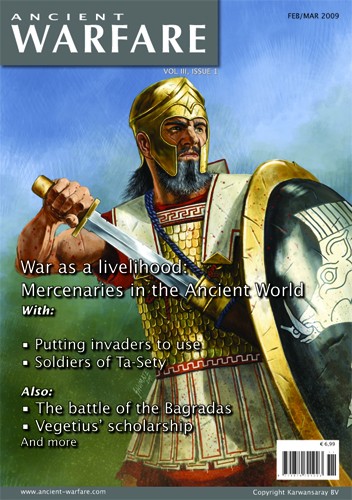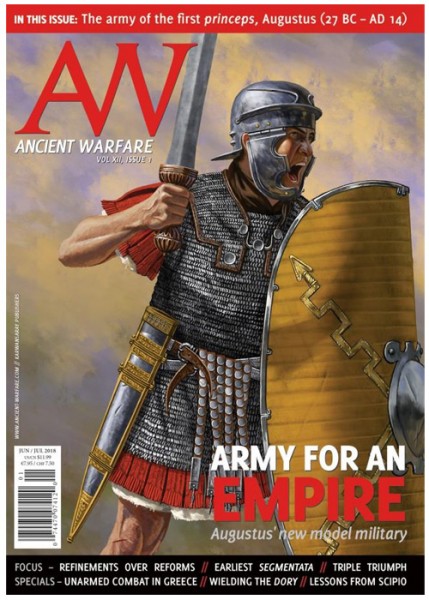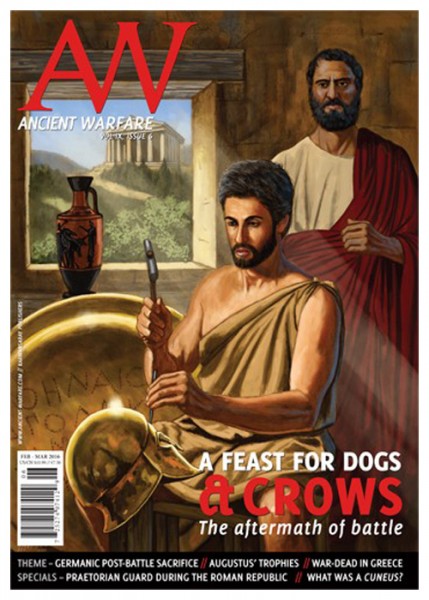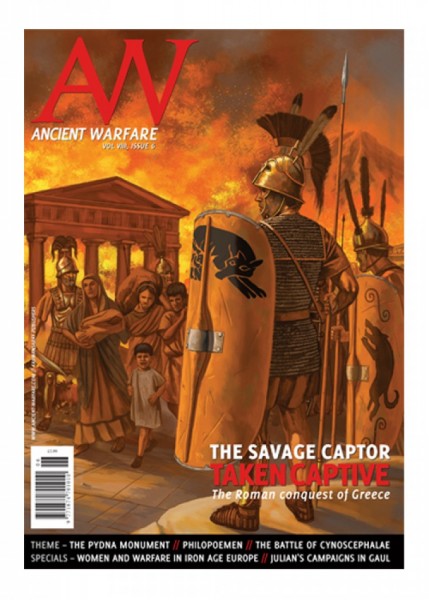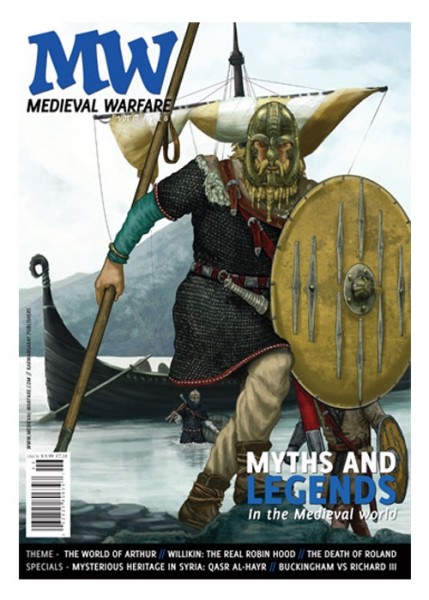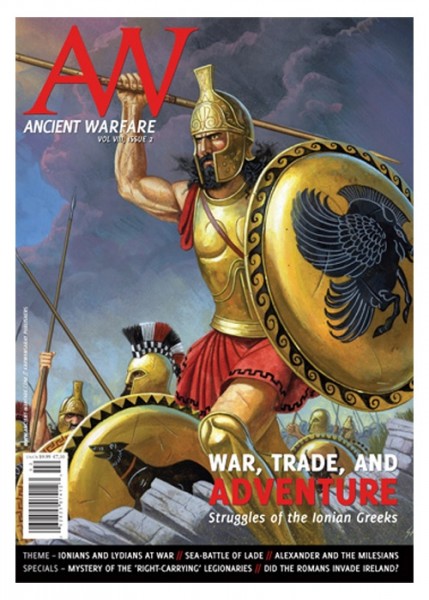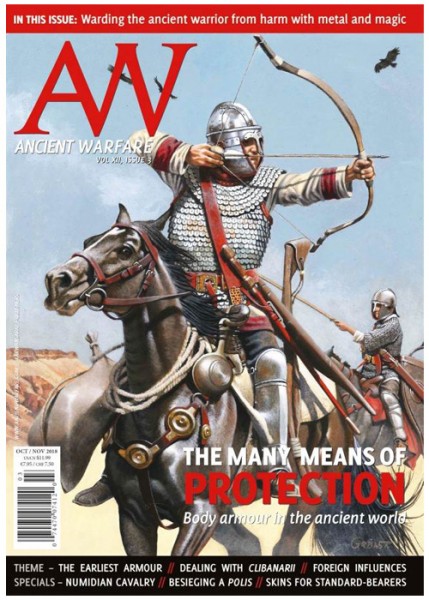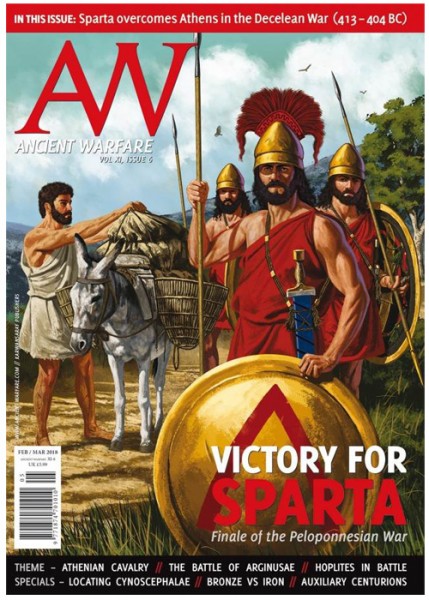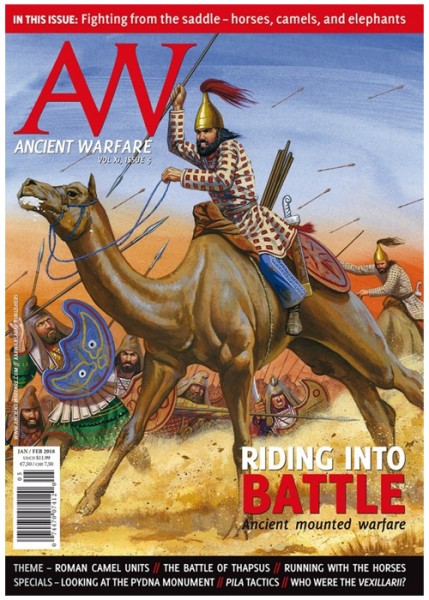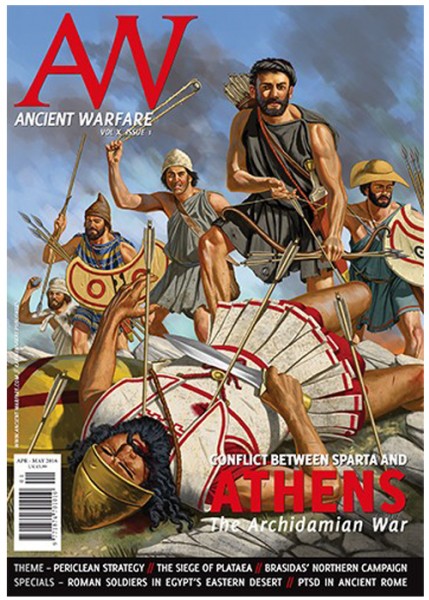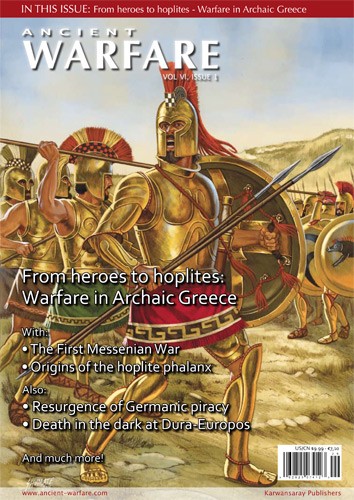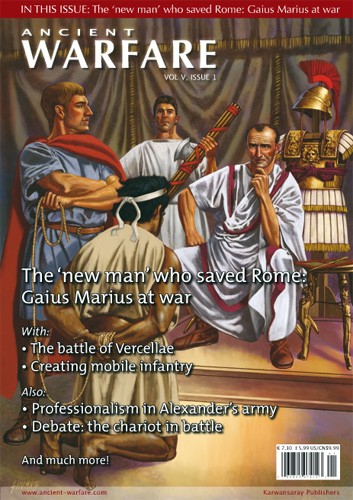Ancient warfare magazine Vol III -1 - War as a livelihood
Artikel-Nr.:
2227000011
7,10 € *
inkl. MwSt. zzgl. Versandkosten
Sofort versandfertig, Lieferzeit ca. 1-3 Werktage
Nur noch 1 Stück auf Lager.
Versandkostenfrei ab 50 € mit GLS in Deutschland
Schneller Versand wahlweise mit DHL oder GLS
Ancient Warfare III.1, Feb/Mar 2009 Release February 10th. Theme: War as a livelihood -... mehr
Produktinformationen "Ancient warfare magazine Vol III -1 - War as a livelihood"
Ancient Warfare III.1, Feb/Mar 2009
Release February 10th.
Theme: War as a livelihood - Mercenaries in the Ancient World
Introduction: Michael Taylor, 'Historical introduction'.
The Source: Duncan B. Campbell, 'Theatre of war.'
The endemic warfare of the Hellenistic world brought an increase in the number of soldiers for hire. Their history can be pieced together from the works of Diodorus Siculus and others. But an interesting sidelight is shed by an unexpected source: the comedies of the Athenian playwright Menander.
Theme: Christian Koepfer, 'Mercenary helmet'
This beautiful and generally unknown bronze helmet from ancient Heraclea (modern Policoro) at the Gulf of Taranto in southern Italy is a fine example of a Southern-Italian-Chalcidian-style helmet with hinged cheek pieces. It was found in grave #1188 in the eastern necropolis of the ancient city and was part of a warrior's panoply.
Theme: Joseph Pietrykowski, 'General-for-Hire'.
Illustrated by Johnny Shumate
The political environment of the fourth century and its corresponding opportunities lead to the regular appearance of the mercenary general in a number of different forms. The true condottiere, a mercenary leader entirely free from state affiliations and following only his own self-interest, had been and would continue to be a relatively rare occurrence in ancient Greece.
Theme: Bridget McDermott, 'Soldiers of Ta-Sety '.
Nubia, now classed as the Middle Nile Valley, is situated in the northern area of modern Sudan and the southernmost part of Egypt. It was known as the first nome (district) of Upper Egypt. The name 'Nubia', may have been derived from the Egyptian word, nb, which means gold, the latter being the most valuable commodity of the region. Nubia was also called Ta-Sety, 'land of the bowmen.' It is often referred to as Wawet by the ancient Egyptians and Kush, by archaeologists.Theme: Ruben Post, 'Mercenary archers'.
When one thinks of light troops in Graeco-Roman armies from the Classical period until the rise of Rome, the first image to come to mind is often that of the ubiquitous Cretan archer. Cretans served far and wide and were perhaps the most famous archers of antiquity. In that age of mercenary warfare the Hellenistic period, Cretans are found fighting for almost every military in the Mediterranean, and it is not uncommon to hear of groups of Cretan mercenaries fighting each other in major battles.
Theme: Paul Bardunias, 'Regulus' demise'.
Illustrated by Carlos de la Rocha and Igor Dzis.
The fate of nations is often decided on battlefields and the course of battles may be decided before they are fought by the tactical genius of great generals. History's foremost military commanders led their people to conquest or fought to stave off being conquered. They fought as usurpers or championed freedom and spread ideologies. Rarely in history have leaders altered the course of history solely for that purest of motives: profit. Xanthippus of Sparta was one such man.
Theme: Alberto Perez Rubio, 'Putting the invaders to use'.
The Galatian invasion and the attack on Delphi in 279 BC, part of the great Celtic expansion of the fourth and third centuries BC, shocked the Hellenistic world in a way very similar to how the tumultus gallicus, the fear of a Gallic invasion, haunted the hearts of Romans since the sack of their city in 390 BC. Galatians became the epitome of the barbaroi, a role played two centuries before by the Persians, a threat to the civilized world that only providential men - Hellenistic basileis (kings) of course, as they themselves would quickly proclaim - could deal with.
Theme: ImageRoss Cowan, 'The emperor as paymaster'.
Illustrated by Johnny Shumate
In the early Imperial era, did the Roman emperors ever employ mercenaries, that is professional warriors from outside the bounds of the empire hired on (relatively) short-term and possibly lucrative contracts, to fulfil specialist functions in which the Roman army was deficient, or to bolster the strength of field armies during particular campaigns or wars?
Features
Be a general: Murray Dahm, 'Vegetius' scholarship'.
Illustrated by Andrew Brozyna.
Vegetius' Epitoma Rei Militaris is the only surviving work from antiquity of a Latin 'science of war' better known as De Re Militari. This genre had a long history stretching back to Cato the elder in the second century BC. Four earlier treatises, none of which survive, were used by Vegetius. Which were these and how did he use them?
Release February 10th.
Theme: War as a livelihood - Mercenaries in the Ancient World
Introduction: Michael Taylor, 'Historical introduction'.
The Source: Duncan B. Campbell, 'Theatre of war.'
The endemic warfare of the Hellenistic world brought an increase in the number of soldiers for hire. Their history can be pieced together from the works of Diodorus Siculus and others. But an interesting sidelight is shed by an unexpected source: the comedies of the Athenian playwright Menander.
Theme: Christian Koepfer, 'Mercenary helmet'
This beautiful and generally unknown bronze helmet from ancient Heraclea (modern Policoro) at the Gulf of Taranto in southern Italy is a fine example of a Southern-Italian-Chalcidian-style helmet with hinged cheek pieces. It was found in grave #1188 in the eastern necropolis of the ancient city and was part of a warrior's panoply.
Theme: Joseph Pietrykowski, 'General-for-Hire'.
Illustrated by Johnny Shumate
The political environment of the fourth century and its corresponding opportunities lead to the regular appearance of the mercenary general in a number of different forms. The true condottiere, a mercenary leader entirely free from state affiliations and following only his own self-interest, had been and would continue to be a relatively rare occurrence in ancient Greece.
Theme: Bridget McDermott, 'Soldiers of Ta-Sety '.
Nubia, now classed as the Middle Nile Valley, is situated in the northern area of modern Sudan and the southernmost part of Egypt. It was known as the first nome (district) of Upper Egypt. The name 'Nubia', may have been derived from the Egyptian word, nb, which means gold, the latter being the most valuable commodity of the region. Nubia was also called Ta-Sety, 'land of the bowmen.' It is often referred to as Wawet by the ancient Egyptians and Kush, by archaeologists.Theme: Ruben Post, 'Mercenary archers'.
When one thinks of light troops in Graeco-Roman armies from the Classical period until the rise of Rome, the first image to come to mind is often that of the ubiquitous Cretan archer. Cretans served far and wide and were perhaps the most famous archers of antiquity. In that age of mercenary warfare the Hellenistic period, Cretans are found fighting for almost every military in the Mediterranean, and it is not uncommon to hear of groups of Cretan mercenaries fighting each other in major battles.
Theme: Paul Bardunias, 'Regulus' demise'.
Illustrated by Carlos de la Rocha and Igor Dzis.
The fate of nations is often decided on battlefields and the course of battles may be decided before they are fought by the tactical genius of great generals. History's foremost military commanders led their people to conquest or fought to stave off being conquered. They fought as usurpers or championed freedom and spread ideologies. Rarely in history have leaders altered the course of history solely for that purest of motives: profit. Xanthippus of Sparta was one such man.
Theme: Alberto Perez Rubio, 'Putting the invaders to use'.
The Galatian invasion and the attack on Delphi in 279 BC, part of the great Celtic expansion of the fourth and third centuries BC, shocked the Hellenistic world in a way very similar to how the tumultus gallicus, the fear of a Gallic invasion, haunted the hearts of Romans since the sack of their city in 390 BC. Galatians became the epitome of the barbaroi, a role played two centuries before by the Persians, a threat to the civilized world that only providential men - Hellenistic basileis (kings) of course, as they themselves would quickly proclaim - could deal with.
Theme: ImageRoss Cowan, 'The emperor as paymaster'.
Illustrated by Johnny Shumate
In the early Imperial era, did the Roman emperors ever employ mercenaries, that is professional warriors from outside the bounds of the empire hired on (relatively) short-term and possibly lucrative contracts, to fulfil specialist functions in which the Roman army was deficient, or to bolster the strength of field armies during particular campaigns or wars?
Features
Be a general: Murray Dahm, 'Vegetius' scholarship'.
Illustrated by Andrew Brozyna.
Vegetius' Epitoma Rei Militaris is the only surviving work from antiquity of a Latin 'science of war' better known as De Re Militari. This genre had a long history stretching back to Cato the elder in the second century BC. Four earlier treatises, none of which survive, were used by Vegetius. Which were these and how did he use them?
Weiterführende Links zu "Ancient warfare magazine Vol III -1 - War as a livelihood"
Cookie-Einstellungen
Diese Website benutzt Cookies, die für den technischen Betrieb der Webseite erforderlich sind und stets gesetzt werden. Andere Cookies, die den Komfort bei Benutzung dieser Website erhöhen, der Direktwerbung dienen oder die Interaktion mit anderen Webseiten und sozialen Netzwerken vereinfachen sollen, werden nur mit Deiner Zustimmung gesetzt.
Konfiguration
Technisch erforderlich
Diese Cookies sind für die Grundfunktionen des Shops notwendig.
Alle Cookies ablehnen
Alle Cookies annehmen
Amazon Pay
Ausgewählter Shop
CSRF-Token
Cookie-Einstellungen
Individuelle Preise
Kunden-Wiedererkennung
Kundenspezifisches Caching
PayPal-Zahlungen
Session
Währungswechsel
Komfortfunktionen
Diese Cookies werden genutzt, um das Einkaufserlebnis noch ansprechender zu gestalten, beispielsweise für die Wiedererkennung des Besuchers.
Erweiterter Merkzettel
Merkzettel
Statistik & Tracking
Endgeräteerkennung
Partnerprogramm
Zuletzt angesehen




